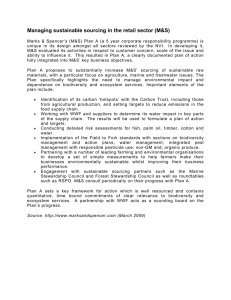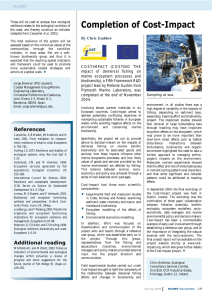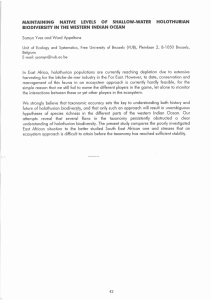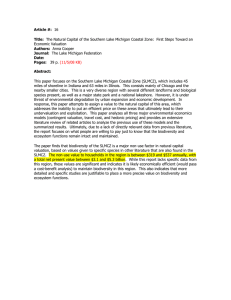Spatial database model of ichthyofauna bioindicators of coastal environmental quality
advertisement
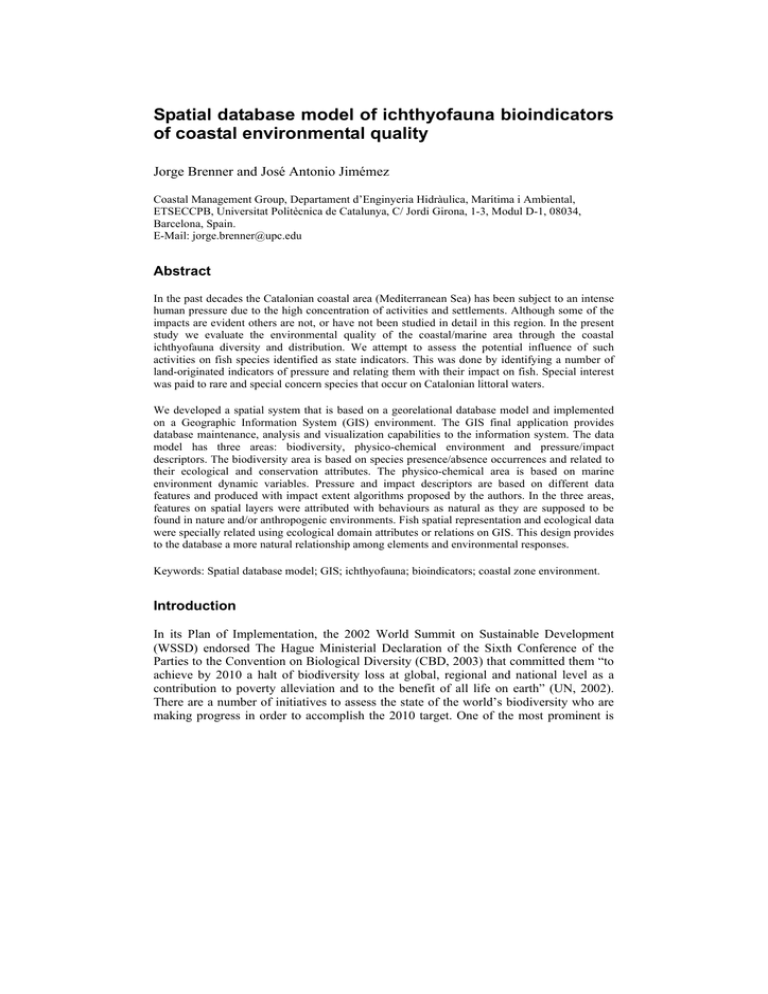
Spatial database model of ichthyofauna bioindicators of coastal environmental quality Jorge Brenner and José Antonio Jimémez Coastal Management Group, Departament d’Enginyeria Hidràulica, Marítima i Ambiental, ETSECCPB, Universitat Politècnica de Catalunya, C/ Jordi Girona, 1-3, Modul D-1, 08034, Barcelona, Spain. E-Mail: jorge.brenner@upc.edu Abstract In the past decades the Catalonian coastal area (Mediterranean Sea) has been subject to an intense human pressure due to the high concentration of activities and settlements. Although some of the impacts are evident others are not, or have not been studied in detail in this region. In the present study we evaluate the environmental quality of the coastal/marine area through the coastal ichthyofauna diversity and distribution. We attempt to assess the potential influence of such activities on fish species identified as state indicators. This was done by identifying a number of land-originated indicators of pressure and relating them with their impact on fish. Special interest was paid to rare and special concern species that occur on Catalonian littoral waters. We developed a spatial system that is based on a georelational database model and implemented on a Geographic Information System (GIS) environment. The GIS final application provides database maintenance, analysis and visualization capabilities to the information system. The data model has three areas: biodiversity, physico-chemical environment and pressure/impact descriptors. The biodiversity area is based on species presence/absence occurrences and related to their ecological and conservation attributes. The physico-chemical area is based on marine environment dynamic variables. Pressure and impact descriptors are based on different data features and produced with impact extent algorithms proposed by the authors. In the three areas, features on spatial layers were attributed with behaviours as natural as they are supposed to be found in nature and/or anthropogenic environments. Fish spatial representation and ecological data were specially related using ecological domain attributes or relations on GIS. This design provides to the database a more natural relationship among elements and environmental responses. Keywords: Spatial database model; GIS; ichthyofauna; bioindicators; coastal zone environment. Introduction In its Plan of Implementation, the 2002 World Summit on Sustainable Development (WSSD) endorsed The Hague Ministerial Declaration of the Sixth Conference of the Parties to the Convention on Biological Diversity (CBD, 2003) that committed them “to achieve by 2010 a halt of biodiversity loss at global, regional and national level as a contribution to poverty alleviation and to the benefit of all life on earth” (UN, 2002). There are a number of initiatives to assess the state of the world’s biodiversity who are making progress in order to accomplish the 2010 target. One of the most prominent is 26 J. Brenner and J.A. Jimémez the Millennium Ecosystem Assessment (2004), which uses the approach of ecosystem services and is currently reviewing the status and trends of biodiversity. Critical to the success of this and similar initiatives is the development of the biodiversity informatics emergent discipline (for a complete description see Canhos et al., 2004). This field has great potential in diverse realms, and represents the conjunction of efficient use and management of biodiversity information with new tools for its analysis and understanding. There are several global and regional efforts that contribute to the development of biodiversity informatics by aiming at organizing data stakeholders and making data available for conservation and sustainable development research. This is the case of the Global Biodiversity Information Facility (GBIF), that since its creation in 2001 has promoted, in conjunction with its partner network (nodes), the development and adoption of standards and protocols for documenting and exchanging biodiversity data. At present, GBIF constitutes the larger biodiversity data access through its Internet portal (www.gbif.org). Likewise, several legal and scientific motivations have emerged and lead to a better understanding of the coastal-marine environment at global and European level. The most relevant global biodiversity informatics initiative is the Census of Marine Life (www.coml.org), that constitutes “a growing network of researchers in more than 45 nations engaged in a 10-year initiative to assess and explain the diversity, distribution and abundance of life in the oceans - past, present, and future” (OBIS, 2005). In order to explain the complex ecosystem dynamics, new initiatives are focussing on the link between biological diversity and ecosystem functioning. In Europe the two main networks that deal with such activities are: the Marine Biodiversity Research in Europe (now finished; www.biomareweb.org), and the Marine Biodiversity and Ecosystem Functioning EU network of Excellence (www.marbef.org). Geographical research on the role of marine biodiversity in ecosystem functioning normally depends on two data types related to the species in concern: taxonomic and distribution. The analysis of these attributes demand high quality standardized data, which are not always available, in contrast to data depth and breath that have become available mainly through the Internet. To our knowledge, besides scarce literature on a few species, only a few distributional data can be found on electronic resources, examples are the Ocean Biogeographic Information System (www.iobis.org), which is the information component of the Census of Marine Life project, and the Sea Around Us Project (www.seaaroundus.org) that focuses primarily on commercial species. Recently, the IUCN Red List provides comprehensive evaluation of ecology and distribution data, providing a framework for assessing the coverage of species but only a few marine species have been revised (IUCN, 2005). As can be seen, there is a new and emerging framework development for the study of marine biodiversity and functioning of ecosystems. Our present work integrates some of the conceptual approaches of the reviewed projects in order to develop an information system spatial data model for assessing the ecological resilience of the coastal-marine ecosystems. In the long-term, this project is expected to contribute to the assessment of Ichthyofauna bioindicators of coastal environmental quality 27 the ecological condition of the Catalonian and Spanish coastal zone socio-economic system. Conceptual approach Even though there is substantial evidence in the literature on how species diversity enhances the ecosystem functioning, most of the model development has been done in the terrestrial rather than the marine environment (see a revision in Loreau et al., 2002). Ecosystem functioning is an abstract concept that can be conceptualized through some of its properties, being stability a relevant one and a surrogate of the system’s equilibrium. Similarly, the stability of an ecosystem can be measured by its resilience. The ecological resilience measures the amount of energy required to move the ecosystem from one organized state of structure to another organized state (Holling, 1973). Commonly, ecosystems are in a transitional-unknown state which ideally is moving forward to a desirable and more sustainable state. In this case, the change rate (energy needed) is a dependent function of the system’s stability, which is also a function of the prevailing structure and function. These are two basic characteristics of ecosystem homeostasis across geographic scales, as presented in Fig. 1. Even though ecological resilience has not been applied frequently in ecology until now (see work of the Resilience Alliance: www.resalliance.org), it has been used “extensively” in its inverse form: vulnerability. Carpenter et al. (2001), Peterson et al. (1998) and other authors suggest that resilience represents in an integral manner the condition of the entire system, while structure and other functioning indicators (individually) represents only one part of it. Accordingly, if the system has more stability then it is more balanced and then it belongs to a better shape ecosystem group of the overall natural system. 28 J. Brenner and J.A. Jimémez B. Desired/sustainable state Ecological resilience Probability of accomplish depends on system’s stability, given by: • • Structure Function A. Unknown transitional state - Multiscale – across scales - Fig. 1. Relation between ecosystem stability and ecological resilience. Ecological resilience has three basic properties that can be used to analyse how it relates to the ecological condition of the coastal system, and therefore constructs a state indicator (adapted from Carpenter et al., 2001): • • • Measures the amount of change that a system can support before it moves from its stable domain. Proxy of the organizational? degree of the system components based in its structure and process. Learning process of the system to adapt to new conditions (and survive). Ichthyofauna diversity For the purposes described, ichthyofauna will be used as the biodiversity group to test the hypothesis. This group has been documented to provide several important functions suggested as relevant for system’s resilience and thus contribute to the ecosystem’s stability (Whitfield and Elliott, 2002; Holmlund and Hammer, 1999). An evaluation of the contribution of fish to the potential ecological resilience will be conducted, specifically using their diversity in link, memory and response functions from a macroecological perspective (ICSU, 2002; Lundberg and Moberg, 2003). Ecological memory is the property of fish diversity to provide essential capacity for reorganization in the form of structure and functions after a disturbance to an ecosystem, which is made 29 Ichthyofauna bioindicators of coastal environmental quality possible due to the resource and process mobile-linking behavior of this group (Lundberg and Moberg, 2003). Complementarily, response is the property of the group that provides the capacity to respond differently to environmental pressures or change, as could be their reproduction diversity (Ives et al., 1999; Folke et al., 2002). These properties will be considered as aggregative characteristics to form functional group clusters. The functions have been analyzed based on their role to improve ecosystem’s capacity of reorganization after the disturbance. The specific structure attributes of fish to be used to form clusters or functional groups are presented in Figure 2. • Swimming mode • Max weight • Total length • Depth range • Environment LINK MEMORY • Reproduction type * • Growth * • Swimming mode • Feeding habit • Total length RESPONSE • Reproduction type * • Growth * • Feeding habit • Depth range * Group of parameters OBI, Hamburg, Dec. 1, 2004 16 Fig. 2. Fish functional groups and attributes. Biodiversity data model A data model is a basic template for implementing Information System projects, as well as GIS projects. It basically deals with data inputting, formatting, geoprocessing, sharing, creating maps, and performing analyses, among other tasks. A data model provides a general framework for writing program codes and maintaining more professional applications, and usually represents the scientific structure for data query, model, visualization and discovery (ESRI, 2004). General taxon-based data models exit widely, but little fundamental understanding of biodiversity - ecosystem functioning has been accomplished with such applications. Sustainable use of biodiversity requires a more holistic, multispecies and ecosystem-based approach, and such a level of understanding of the distribution patterns and relations among species and the ecosystem 30 J. Brenner and J.A. Jimémez needs to be based on a robust spatial biogeographical data model (Tsontos and Kiefer, 2003). A Biogeographic Information System mostly focuses on the integration, analysis visualization and discovery of species and environmental variables, such as biological, physical and chemical. The spatial modelling capacities of the system will be established by the data model definition and complexity, and determine its power to address one or more of the next issues: • • • • • Biogeographic complexity Role of biodiversity function Ecosystem’s ecological condition Conservation priorities and gaps Monitoring/management tool for ICZM Biogeographic Information System The Biogeographic Information System was developed as a georelational database model and implemented on a GIS environment. The spatial information system provides maintenance, analysis and visualization capabilities to the data bases. The system main modules are: marine biodiversity, environmental (physico-chemical) and socioeconomic. Spatial features of three modules were attributed with behaviours as natural as they were supposed to be found in nature and/or anthropogenic environments, and structured by several geo-ecological domains as habitats, sites (conservation) and other tiling forms as distribution (species range), ecological communities and geopolitical boundaries. See module structure in Figure 3. The design characteristics provide a natural relationship among elements and environmental responses. The system also uses a metadata module compliant with the FGDC standards. A series of vector and raster spatial features were defined as part of the catalog of the data model. Features were selected from other existing and successful implemented ESRI GIS data models as the Marine Data Model (Oregon State, Duke University and ESRI; homepage: http://dusk.geo.orst.edu/djl/arcgis/index.html) and the Biodiversity Data Model (NatureServe and ESRI) (ESRI, 2004). Spatial features used in the Biogeographic Information System are presented in Table I. 31 Ichthyofauna bioindicators of coastal environmental quality Table I. Marine GIS features used in the Biogeographic Information System (modified from Halpin, 2002). Fixed points Instantane Survey ous points points Boundary Areas lines ID X,Y Z ID X,Y ∆Z t ID X1,Y1;X2, Y2… Z Time duration areas Feature ID X,Y ∆Z t1…t2 Regularly interpolat ed surfaces ID ID row1,col1 X1,Y1;X2, X1,Y1;X2, …rown,col Y2…X1,Y1 Y2…X1,Y1 n Z Z Z1…Zn t1…tn Irregularly Volumes interpolat ed surfaces row1,col1 …rown,col n Z1…Zn ID X1,Y1,Z1; X2,Y2,Z2 Attributes …X1,Y1,Z 1 Z t1…tn Ocurrence, Biodiversit Samples, Shoreline, Habitats, Oil spill, Predicted TINs, Front, conservati y transects EEZ, not distribution presence / distribution bathymetry plume, 3D on status observatio enclosing s, patches, absence, , habitat Examples n, fish area, legal MPAs, range bathymetry densities, boundaries pressure, , SST, CTD, XBT , impact, climatology pressures, ecoregion, , GeoTiff impacts community The core biogeographic module is based on a general Species Index which serves a unique taxonomic ID for the species and functional group sub-data bases and entities. It also integrates the Element Occurrence (EO; species georeference) entities, as well as any input records from external databases. Implemented species sub-database entities are: taxonomic, conservation, ecological (observational) and information sources. Core biogeographic Geo-structured domains Tiling Species index Habitats Habitats Species EOs Functional groups Sites Other unit Fig. 3. Conceptual entities and relations of the biogeographic module. 32 J. Brenner and J.A. Jimémez Community level resilience As a second phase under development of this project, we implemented the Biodiversity Information System for the assessment of the ecological condition of the Catalonian coastal zone socio-economic system. The Catalonian coast is one of the fastest developing areas in the Western Mediterranean, having more that 40% of its population (2.8 mill.) living in coastal municipalities (IDESCAT, 2004). Coastal activities, as recreation and urbanization demand large areas and are considered to be the two major sources of environmental pressures along the coast. This region is now preparing itself for the implementation of an Integrated Coastal Zone Management (ICZM) Strategy (GenCat, 2004); therefore there is an increased interest to assess the environmental services that the coastal zone provides to the global socio-economic system. This need has put scientists to work on the understanding of the properties that provide stability to the ecological systems, thus goods and services to the society. Benthic communities and fish occurrences along the more than 800km of the Catalonian coast have been cartographied in the Biodiversity Information System. In the spatial analysis we will calculate the resilience based on the contribution of previous defined functional groups at each community. The model will also use the input of additional spatial sub-models that have been developed to study their interaction with communities’ resilience to perform a fuzzy algorithm. See the conceptual model in Figure 4. Structure template Taxa occurrence 1 . . . N Functional diversity groups Resilience algorithm Output Criteria Resilience Link Criteria Response Memory GIS sub-models Fish Community unit (1 . . . N) Input • Marine communities • Pressure – impacts • Vulnerability OBI, Hamburg, Dec. 1, 2004 Fig. 4. Conceptual model of resilience analysis at community level. 8 Ichthyofauna bioindicators of coastal environmental quality 33 An assessment of the total resilience of the system will be based on the individual values of the coastal benthic communities. In most areas fish is a well know biodiversity group; and thus it is expected that the resulting spatial indicators and framework could be used to promote more sustainable coastal strategies and actions at a global scale. Conclusions In this project we focused on biodiversity functions that contribute at system level and as biotic integrators of ecosystem dynamics, since biodiversity can provide a number of functions that has been proved to be necessary for ecosystem resilience. The resilience is enhanced by the distribution of functional groups at within scale and across multiple scales without meaning redundancy, but overlapping on time and space (complementarily). Building resilience can be a better management strategy of controlling the ecosystem, in order to provide and/or maintain the ecosystem functions. A resilient ecosystem constitutes a more stable state/condition, prevents disturb-enforced change and improves the system components viability. Similarly, fish diversity is supposed to have beneficial effects on the stability of the processes of the marine ecosystem, thus the identification of taxa clusters will characterize their response to various environmental disturbances. The developed marine biodiversity data model has integrated several designing and implementation best practices from existing models. Although it has only been implemented using fish diversity, we consider that a robust biogeographic data model has been developed. Furthermore, it has been designed as a platform-independent conceptual model, which provides a flexible template for other marine applications. The development of spatial bioindicators can be better accomplished at a macroecological level, since high detailed occurrence or distributional data is commonly absent. We also found that the species-presence-only data in relation to the environmental factors and coastal originated human impacts is scale dependent of the biophysical model structure that has been defined. This can be integrated in a more efficient data model through the behaviour definition of the spatial features that also need to be structured by hierarchical domains. The design (modelling) of species behaviours is directly influenced by data depth, breath and quality and determines the implementation of the data conceptual model. Acknowledgements This paper arose from work carried out by the Coastal Management Group of the Universitat Politècnica de Catalunya and their interest on the coastal and marine environment. We are grateful to all members of the group for their useful discussions and to the Marine Engineering Laboratory for initiating and supporting the group activities. We also would like to give a special gratitude to the Fishbase Project Group for the data of Catalonian Sea fish fauna. Finally, thanks to the anonymous reviewers that helped to clarify this presentation and paper. 34 J. Brenner and J.A. Jimémez References Canhos V.P., S. Souza, R. Giovanni and D.A.L. Canhos. 2004. Global biodiversity informatics: setting the scene for a “new world” of ecological modeling. Biodiversity Informatics 1:1-13. Carpenter S., B. Walker, J.M. Anderies and N. Abel. 2001. From metaphor to measurement: resilience of what to what. Ecosystems 4: 765-781. CBD. 2003. Handbook of the Convention on Biological Diversity. Second Edition. Secretariat of the Convention on Biological Diversity. Montréal. ESRI. 2004. Data models. Environmental Systems Research Institute. http://support.esri.com/index.cfm?fa=downloads.dataModels.gateway. October, 2004. Folke C., J. Colding and F. Berkes. 2002. Building resilience for adaptive capacity in social-ecological systems. In: Navigating social-ecological systems: building resilience for complexity and change. Berkes, F., J. Holding and C. Folke (Eds.). Cambridge University Press. Cambridge. GenCat. 2004. Plan estratégico para la gestión integrada de las zonas costeras de Cataluña. Memoria Ambiental. DMAiH. Generalitat de Catalunya, Barcelona. 66p. Halpin P. 2002. Marine GIS data model. ArcMarine: The ArcGIS Marine Data Model. Presentation downloaded from http://dusk.geo.orst.edu/djl/arcgis/index.html. October, 2004. Holling C.S. 1973. Resilience and stability of ecological systems. Annu Rev Ecol Syst 4:1-23. Holmlund C.M. and M. Hammer. 1999. Ecosystem services generated by fish populations. Ecological Economics 29:253-268. IDESCAT. 2004. Anuari estadístic de Catalunya 2004. Institut d’Estadística de Catalunya. Barcelona. http://www.idescat.es/. October, 2004. International Council for Science. 2002. Resilience and sustainable development. ICSU Series on Science for Sustainable Development. No. 3, 37 pp. IUCN. 2005. IUCN Red List of Threatened Species. http://www.redlist.org/. January, 2005. Ives A.R., K. Gross and J.L. Klug. 1999. Stability and variability in competitive communities. Science 286:542-544. Loreau M., S, Naeem and P. Inehausti. 2002. Biodiversity and ecosystem functioning, synthesis and perspectives. Oxford University Press, Avon. 294 pp. Lundberg J. and F. Moberg. 2003. Mobile link organisms and ecosystem functioning: implications for ecosystem resilience and management. Ecosystems 6:87-98. Millennium Ecosystem Assessment. 2004. Millennium Ecosystem Assessment. http://www.millenniumassessment.org. November, 2004. OBIS. 2005. Ocean Biogeographic Information System. http://www.iobis.org/. January, 2005. Peterson G., C.R. Allen and C.S. Holling. 1998. Ecological resilience, biodiversity, and scale. Ecosystems 1:6-18. Tsontos V.M. and D.A. Kiefer. 2003. The Gulf of Maine biogeographical information system project: developing of a spatial data management framework in support of OBIS. Oceanologica Acta 25:199-206. Ichthyofauna bioindicators of coastal environmental quality 35 United Nations. 2002. Report of the World Summit on Sustainable Development. Johannesburg, South Africa. Whitfield A.K. and M. Elliott. 2002. Fishes as indicators of environmental and ecological changes within estuaries: a review of progress and some suggestions for the future. Journal of Fish Biology 61 (Supp. A):229-250.
